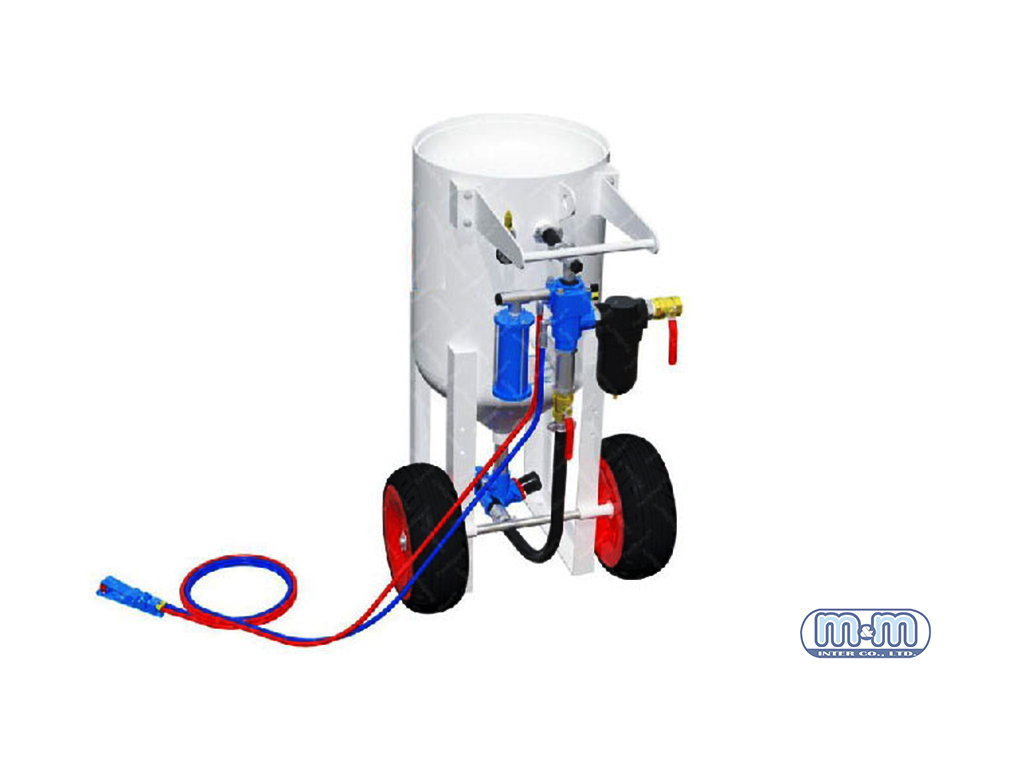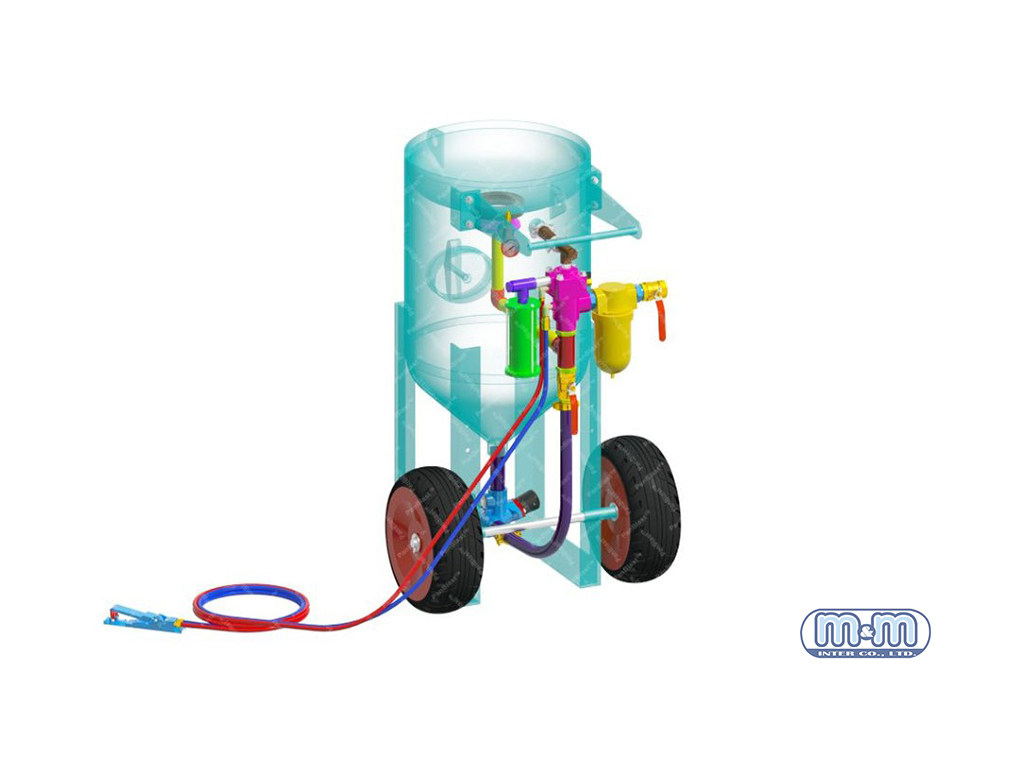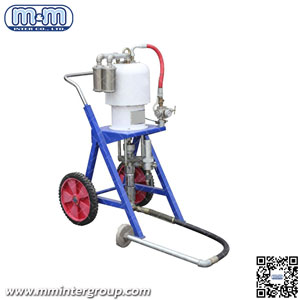BP300
BP300-1 Blast Pots
Product Features
PanBlastTM BP Series Blast Pots are available in multiple configurations and specifications to suit varying market requirements worldwide. The BP300-1 is a medium-capacity, automation blast pot, suitable for general blasting.
Designed and manufactured in accordance with international standards and requirements.
Uniflo combination type remote control valve.
AirFlo air-bleed type pneumatic deadman handle.
Fina ll type abrasive control valve for precise metering and easy maintenance.
Moisture trap, exhaust muffler and main air isolation valve standard.
Wide, pneumatic wheels for increased maneuverability and stability.
100 liters (3ft3) abrasive capacity, 125 or 150psi pressure rating.
32mm (1-1/4”) fittings.
Common applications
On site industrial and commercial blasting.
Blast and painting contractor yard work.
Blast room applications with or without abrasive recovery systems.
In situ blasting in shipyards and slipways.
BP300-1 ZVP
BP300-1 หม้อระเบิด
คุณสมบัติของสินค้า
Blast Pots ซีรีส์ PanBlastTM BP มีจำหน่ายในการกำหนดค่าและข้อมูลจำเพาะที่หลากหลาย เพื่อให้เหมาะกับความต้องการของตลาดที่แตกต่างกันทั่วโลก BP300-1 เป็นหม้อระเบิดอัตโนมัติความจุปานกลาง เหมาะสำหรับการพ่นทั่วไป
ออกแบบและผลิตตามมาตรฐานและข้อกำหนดสากล
วาล์วควบคุมระยะไกลชนิดรวม Uniflo
ด้ามจับเดดแมนแบบลม AirFlo ชนิดไล่ลม
วาล์วควบคุมการขัดถูชนิด Fina ll เพื่อการสูบจ่ายที่แม่นยำและการบำรุงรักษาง่าย
มาตรฐานตัวดักความชื้น ตัวเก็บเสียงไอเสีย และวาล์วแยกอากาศหลัก
ล้อลมกว้างเพื่อเพิ่มความคล่องตัวและความมั่นคง
ความสามารถในการขัด 100 ลิตร (3 ฟุต 3) อัตราแรงดัน 125 หรือ 150 psi
ข้อต่อขนาด 32 มม. (1-1/4 นิ้ว)
การใช้งานทั่วไป
การระเบิดในสถานที่อุตสาหกรรมและเชิงพาณิชย์
รับเหมางานวางระเบิดและทาสีลานบ้าน
การใช้งานห้องระเบิดที่มีหรือไม่มีระบบการกู้คืนที่มีฤทธิ์กัดกร่อน
เหตุระเบิดในอู่ต่อเรือและทางลื่น
BP300-1 ซีวีพี
#เม็ดเซรามิก #ลวดตัดทองแดง #อะลูมิเนียมช็อต #ลวดตัดอะลูมิเนียม #ซิลิกอนคาร์ไบด์สีดำ #สังกะสีช็อต #หินขัดพลาสติก #หินขัดเซรามิก #Sandblasted glass#Sand blasting machine#Copper Slag#เมลามีนขัดพลาสติก#shotblasting# การพ่นทราย#ทรายขัดโกเมน #maintenanceshotblast#blastingmachine#สารขัดถู#สารขัดถูพลาสติก#สารขัดถูโลหะ< /span>#ทรายขัด a>#การพ่นทราย a>#ลูกปัดแก้ว#เปลือกวอลนัท< /span>#Polishing media#Aluminium Oxide#Carbon steel pellets#Plastic abrasive grit#walnut shell#corn cob#corn cob#Stainless Steel Ball#Carbon Steel Ball#Stainless Steel Ball#Stainless steel cutting wire#Glass beads#steel shot#steel shot abrasive blasting#Steel Grit Abrasive Blasting#Sand polishing#Garnet sand#Polish Garnet#Sell spraying machine#Sand blasting machine repair#Sand blasting machine spare parts#Sand blasting machine spare parts#Sand blasting service#Metal surface polishing machine#Sandblasting machine#Sandblasting machine #Surface polishing work #Photograph sand and water#Polish#Polish #Sandblasting#Sandblasting#Polishing powder#Premium Polishing Powder#Polishing #Sandblasting#Sandblasting#Steel Grit
Sandblasting and shotblasting are two common methods of abrasive blasting used for surface preparation and cleaning. Although they share similarities, there are some key differences between the two methods.
Sandblasting, also known as abrasive blasting or media blasting, uses compressed air to propel small particles of abrasive material (such as sand, glass beads, or aluminum oxide) at high speeds against a surface to remove coatings, rust, or other surface contaminants. Sandblasting is often used in industrial applications, such as in the automotive or construction industry, to prepare surfaces for painting, coating, or bonding.
Shotblasting, on the other hand, uses small steel balls, known as shot, to clean and prepare surfaces. The shot is propelled at high speeds against a surface using a specialized machine, called a shot blaster. Shotblasting is often used to remove surface contaminants, such as rust or scale, from metal surfaces, and to prepare concrete surfaces for coatings or overlays.
The main difference between sandblasting and shotblasting is the type of abrasive material used. While sandblasting uses a variety of materials, shotblasting specifically uses steel shot. This can make shotblasting more effective at removing tough surface contaminants, such as rust or heavy coatings, from metal surfaces. However, sandblasting is often preferred for more delicate surfaces, such as wood or stone, as it can be used with gentler abrasives.
Another key difference between the two methods is the equipment used. Sandblasting typically uses a handheld nozzle and air compressor to propel the abrasive material, while shotblasting requires specialized equipment such as a shot blaster machine.
Overall, both sandblasting and shotblasting are effective methods for surface preparation and cleaning, and the choice between the two depends on the specific application and surface being worked on.







